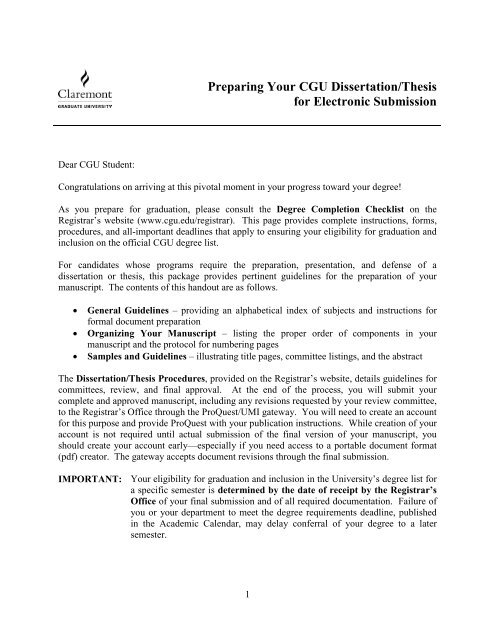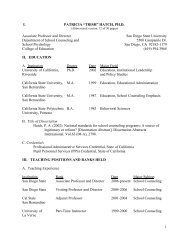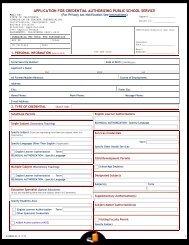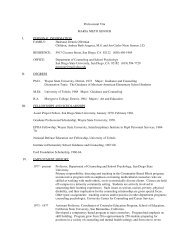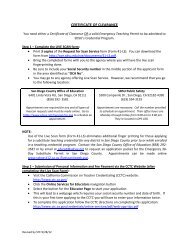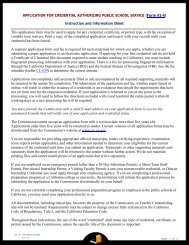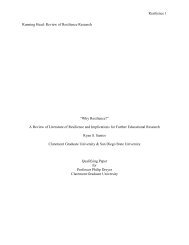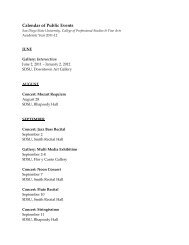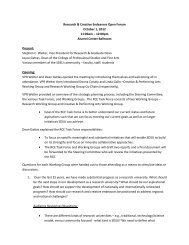Electronic Submission Guidelines - SDSU
Electronic Submission Guidelines - SDSU
Electronic Submission Guidelines - SDSU
You also want an ePaper? Increase the reach of your titles
YUMPU automatically turns print PDFs into web optimized ePapers that Google loves.
Preparing Your CGU Dissertation/Thesis<br />
for <strong>Electronic</strong> <strong>Submission</strong><br />
Dear CGU Student:<br />
Congratulations on arriving at this pivotal moment in your progress toward your degree!<br />
As you prepare for graduation, please consult the Degree Completion Checklist on the<br />
Registrar’s website (www.cgu.edu/registrar). This page provides complete instructions, forms,<br />
procedures, and all-important deadlines that apply to ensuring your eligibility for graduation and<br />
inclusion on the official CGU degree list.<br />
For candidates whose programs require the preparation, presentation, and defense of a<br />
dissertation or thesis, this package provides pertinent guidelines for the preparation of your<br />
manuscript. The contents of this handout are as follows.<br />
• General <strong>Guidelines</strong> – providing an alphabetical index of subjects and instructions for<br />
formal document preparation<br />
• Organizing Your Manuscript – listing the proper order of components in your<br />
manuscript and the protocol for numbering pages<br />
• Samples and <strong>Guidelines</strong> – illustrating title pages, committee listings, and the abstract<br />
The Dissertation/Thesis Procedures, provided on the Registrar’s website, details guidelines for<br />
committees, review, and final approval. At the end of the process, you will submit your<br />
complete and approved manuscript, including any revisions requested by your review committee,<br />
to the Registrar’s Office through the ProQuest/UMI gateway. You will need to create an account<br />
for this purpose and provide ProQuest with your publication instructions. While creation of your<br />
account is not required until actual submission of the final version of your manuscript, you<br />
should create your account early—especially if you need access to a portable document format<br />
(pdf) creator. The gateway accepts document revisions through the final submission.<br />
IMPORTANT: Your eligibility for graduation and inclusion in the University’s degree list for<br />
a specific semester is determined by the date of receipt by the Registrar’s<br />
Office of your final submission and of all required documentation. Failure of<br />
you or your department to meet the degree requirements deadline, published<br />
in the Academic Calendar, may delay conferral of your degree to a later<br />
semester.<br />
1
GENERAL GUIDELINES<br />
Unless you impose embargos through ProQuest—that is, formally withhold public access to your<br />
dissertation or thesis for a specified period of time—your publication is available to the world<br />
through the Honnold Library as well as through other open access systems.<br />
• You must comply with all publication standards and protocols to avoid copyright<br />
infringement of other intellectual property.<br />
• Your final submission must be print-ready and should reflect your personal organization,<br />
expertise, and professionalism.<br />
The generally accepted manual for preparation of dissertations and theses is referenced below.<br />
This manual provides formatting guidelines and suggestions for footnotes, bibliographies, and<br />
other composition standards.<br />
General<br />
Reference<br />
Turabian, Kate L., A Manual for Writers of Term Papers, Theses, and<br />
Dissertations. University of Chicago Press, 1996. (ISBN 0-226-81627-3)<br />
In general, follow the recommendations of your review committee, especially if there are<br />
specific requirements for your discipline. Note that to comply with applicable laws and<br />
regulations, some disciplines or degrees may impose additional requirements and specifications<br />
for academic publications.<br />
Abstract<br />
Details and sample format are provided in the Samples section at the end<br />
of this document.<br />
Acknowledgements Optional. An Acknowledgements page is not necessary, but may be used<br />
to recognize individuals and other entities who significantly contributed to<br />
the development and composition of your manuscript. Examples of such<br />
entities may include committee members, outside readers, an individual<br />
who helped formulate your proposal, or a contributor of research,<br />
computer work, statistical analysis, or graphics. Funding resources for<br />
research support are appropriately recognized in an Acknowledgements<br />
page.<br />
Note that the Acknowledgements page is your manuscript’s first formal<br />
page. It should be numbered using a lower case Roman numeral—for<br />
example, vi.<br />
Appearance<br />
Your document must be professional and print-ready for publication. The<br />
organization and appearance of your electronic copy should be clean, clear,<br />
and consistent in quality. Print copies are generally produced as two-sided<br />
CGU Registrar’s Office, January 2011
pages. Remember that documents may be reduced in size for microfilm<br />
reproductions.<br />
Chapter 1<br />
Committee<br />
Page<br />
Copyright<br />
Permissions<br />
If no Introduction is included, the first page of Chapter 1 begins the Arabic<br />
numbering sequence of your manuscript. All subsequent pages should be<br />
numbered through the end of your reference sections, including pages with<br />
illustrations, graphs, figures, charts, or plates.<br />
Details and sample format are provided in the Samples section at the end<br />
of this document. Approval signatures are not included in the official<br />
submission of your manuscript. Approval of your manuscript, documented<br />
by the Certification of Committee/Department Approval cited in the<br />
Registrar’s Dissertation/Thesis Procedures, is permanently retained with<br />
the University’s grade rosters.<br />
Your manuscript must adhere to professional publications standards. As<br />
the responsible author, you should be careful using or incorporating into<br />
your manuscript extensive texts, images, or other intellectual property.<br />
Wherever required, you must obtain and retain for your records the<br />
appropriate copyright permissions.<br />
As a rule, obtain all permissions in writing, specifically citing the content<br />
which you may reproduce and identifying the purpose for the reproduction.<br />
Whenever extensive materials from a single source are used or<br />
incorporated into your document, you should express gratitude and note<br />
the permission obtained in your Acknowledgements. For single items such<br />
as images, photographs, or other graphics, you may include the disclaimed<br />
“Used by permission” directly below the insert.<br />
Claremont Graduate University is neither responsible nor liable for any<br />
copyright infringement on the part of dissertation or thesis authors.<br />
Questions about author liabilities and copyright law should be referred to<br />
an attorney.<br />
Dedication<br />
A dedication or Dedication page is not required; however, an author may<br />
choose to honor individuals such as parents, spouses, significant others, or<br />
mentors.<br />
No page number is printed on the Dedication page.<br />
Fold-outs<br />
In a paper or hard copy print environment, fold-outs are used for tables and<br />
illustrations that would require space that exceeds the breadth or<br />
dimensions of a single page. In an electronic environment, output for print<br />
is generally to 8-1/2 x 11” pages. Copy that requires non-traditional<br />
printing or presentation should be submitted as a supplemental document<br />
to your manuscript. The ETD provides guidelines for uploading<br />
CGU Registrar’s Office, January 2011
supplemental files, including information on size specifications, and<br />
placement instructions. Contact ProQuest through the ETD with any<br />
concerns regarding non-standard pages.<br />
It is good practice to verify acceptance of supplemental files and nonstandard<br />
format documents with your review committee.<br />
Footnotes<br />
Font<br />
Images and<br />
Photographs<br />
Indentations<br />
Introduction<br />
Italics and<br />
Bold Face<br />
Landscape<br />
Pages<br />
Margins<br />
Use a consistent format that best meets your presentation needs. Footnotes<br />
may be presented at the bottom of a page, at the end of a chapter, or at the<br />
end of your manuscript.<br />
Use 10 point or larger. Any standard font is acceptable; however, use the<br />
same font throughout the document. Do not use fonts that resemble scripts<br />
or other novelty or customized fonts. These fonts may not convert in the<br />
publication of your manuscript and may negatively impact the appearance<br />
and organization of your manuscript.<br />
Images and photographs—black & white or color—are acceptable. To<br />
avoid copyright infringement or unauthorized use, be sure to obtain<br />
permissions or any approvals for re-publication or reproduction of these<br />
images and photographs.<br />
Indent paragraphs in a consistent manner and style that best meets the<br />
needs of your manuscript or discipline.<br />
Optional. If included, the first page of your Introduction begins the Arabic<br />
numbering of your manuscript. All subsequent pages should be numbered<br />
through the end of your reference sections, including pages with<br />
illustrations, graphs, figures, charts, or plates.<br />
Restrict usage of highlighted fonts such as italics and bold face to<br />
instances in your text that require special emphasis. Non-English words<br />
and phrases should always be italicized.<br />
Landscape formats are acceptable for tables and illustrations that require<br />
space that exceeds the breadth of a portrait orientation. If possible,<br />
number the page at the bottom center of the portrait orientation view.<br />
Margin requirements apply to all pages of the manuscript, including<br />
appendices, indices, etc.<br />
• Left and right margins: 1-1/2”<br />
• Top and bottom margins: at least one inch<br />
Note that print copies of your manuscript are produced double-sided. Be<br />
sure to take this point into consideration when positioning tables, graphics,<br />
or other images that extend into the margin fields.<br />
CGU Registrar’s Office, January 2011
Order/<br />
Sequence<br />
For organizational, numbering, and publication purposes, manuscripts are<br />
typically divided into three main parts.<br />
• Preliminary Sections<br />
• Text<br />
• References<br />
For more information, see the section on Organizing Your Manuscript.<br />
Pagination<br />
Count ALL pages of your document—including pages with illustrations,<br />
graphs, figures, charts, or plates—through the end of all appendices. Your<br />
numbering should allow for blank pages that, although a number is not<br />
printed on the page, the page is nevertheless counted as part of your<br />
volume.<br />
• Preliminary Sections: Use lower case Roman numerals—v, vi, vii,<br />
etc.<br />
• Text: Start using Arabic numbers—1, 2, 3, etc—with the first page<br />
of the Introduction or with the first page Chapter One if your<br />
manuscript does not include an Introduction. All pages should be<br />
numbered without breaks in the numbering sequencing.<br />
• For consistency and to accommodate binding needs of printed<br />
copies, locate page numbers at the bottom center of each page.<br />
See also the Manuscript Ordering and Numbering Protocol table in the<br />
Organizing Your Manuscript section of this document.<br />
Paper<br />
Specifications<br />
Paper<br />
<strong>Submission</strong>s<br />
Not applicable. Manuscripts are submitted electronically through the<br />
ETD.<br />
Manuscripts are submitted electronically through the ETD. Contact the<br />
Registrar’s Office if, for some reason, you are unable to submit your<br />
manuscript electronically.<br />
NOTE: Authors who are unable to use the electronic process are<br />
responsible for all expenses in the production and distribution of their<br />
manuscripts for review as well as for the final submission of two clean<br />
copies. Additional publication costs, which are waived for authors using<br />
the electronic process, are required at the time of submission of the two,<br />
clean paper copies.<br />
Permissions<br />
Preface<br />
Print Copies<br />
See Copyright Permissions, above.<br />
If you include a Preface, it follows the Acknowledgements page and<br />
continues numbering using lower case Roman numerals.<br />
Printed copies are generally produced using double-sided pages. Please<br />
CGU Registrar’s Office, January 2011
keep this mind when organizing pages with tables, illustrations, images, or<br />
other graphics, as well as when numbering your pages (bottom center).<br />
Questions<br />
Signatures<br />
Manuscript preparation: your review committee.<br />
<strong>Electronic</strong> manuscripts: use the help links in the ETD.<br />
CGU Dissertation/Thesis Procedures require submission of a Certification<br />
of Committee/Department Approval form as verification of acceptance of<br />
your manuscript. This document is permanently maintained in the<br />
University’s records with other grade rosters.<br />
To comply with best practices in the prevention of identity theft, the<br />
approving signatures of your review committee are not included in the<br />
published version of your manuscript. Committee chair and members<br />
should be listed by name, institution or organization, and title as illustrated<br />
in the samples at the end of this document.<br />
Spacing<br />
Manuscripts should be double-spaced, although exceptions may be made<br />
for the following items.<br />
• Footnotes<br />
• Long quotations<br />
• Tables, where double spacing may be detrimental to the<br />
presentation of data or information<br />
• Table of Contents, where chapters may have numerous sections<br />
listed<br />
Standards<br />
<strong>Submission</strong>s<br />
Table of<br />
Contents<br />
Unless established by a particular department or discipline, there are no<br />
universal standards regarding caps, boldface, or italics where title pages<br />
are concerned. Writers are urged to adopt a consistent and professional<br />
protocol for use throughout the manuscript.<br />
Manuscripts are submitted electronically through the ETD. Instructions<br />
are provided in the Registrar’s Dissertation/Thesis Procedures on the web.<br />
See also the note for Paper <strong>Submission</strong>s.<br />
Use the Table of Contents to list the significant headings and subheadings<br />
of your manuscript. The Table of Contents may be followed by additional<br />
lists, such as of tables, diagrams, figures, illustrations, plates, or the like.<br />
Pages of your Table of Contents continue numbering using lower case<br />
Roman numerals.<br />
Title Page<br />
Details and sample format are provided in the Samples section at the end<br />
of this document.<br />
CGU Registrar’s Office, January 2011
ORGANIZING YOUR MANUSCRIPT<br />
Follow the protocol below to organize your manuscript and to determine the numbering scheme<br />
that applies to each section of the manuscript.<br />
MANUSCRIPT ORDER AND NUMBERING PROTOCOL<br />
INSTRUCTIONS FOR NUMBERING<br />
PAGE COUNT PRINT TYPE<br />
1 Title Page Yes No N/A<br />
2 Copyright Page (optional) Yes No N/A<br />
3 Committee Listing Page Yes No N/A<br />
4 Abstract (for Dissertations) Yes No N/A<br />
5 Dedication (optional) Yes No N/A<br />
6 Acknowledgements (optional) Yes Yes Small Roman numeral,<br />
page v or vi<br />
7 Preface (optional) Yes Yes Small Roman numeral<br />
8 Table of Contents Yes Yes Small Roman numeral<br />
9 Table of Figures or Plates (optional) Yes Yes Small Roman numeral<br />
10 Introduction (optional) Yes Yes Arabic, start with page 1<br />
11 Chapter One Yes Yes Arabic<br />
While the title page and other preliminary pages do not have numbers printed on them, these<br />
pages are, nevertheless, counted. The first page on which a number is actually printed must take<br />
into account the number of pages that precede it. For example, in the table, the suggestion for<br />
the Acknowledgements page is given with an indication of a page numbering of v or vi or<br />
whatever may be applicable.<br />
Note that some of the items listed in this table are optional. Consult with your department or<br />
review committee for individual standards appropriate to your discipline.<br />
ALL pages of the manuscript are counted whether or not a page number is displayed at the<br />
bottom of the page. (Samples and additional guidelines are provided in the last section of this<br />
document.)<br />
SAMPLES AND GUIDELINES REGARDING SPECIFIC PAGES<br />
This section presents samples of wording and format structure for specific pages of your<br />
dissertation. Illustrations are designed to illustrate format and are not according to scale.<br />
CGU Registrar’s Office, January 2011
Title Page<br />
(Title of Manuscript)<br />
(See text below for alternate wording option)<br />
by<br />
(Your Name)<br />
Claremont Graduate University<br />
(Calendar Year of Your Degree)<br />
© Copyright (Your Name), (Year)<br />
All rights reserved.<br />
Title. Your title should reflect the subject or focus of your manuscript and will be the basis for<br />
keywords for internet and library searches. While not recommended, you may use an alternate<br />
title format that provides a generic or simple statement identifying your manuscript as the final<br />
degree requirement of your program. Two examples of such general wording are provided<br />
below.<br />
For CGU Programs. A final project submitted to the Faculty of Claremont Graduate<br />
University in partial fulfillment of the requirements for the degree of (name)<br />
For CGU Joint Programs. A (dissertation/thesis) submitted to the Faculty of Claremont<br />
Graduate University and (the Joint Institution Name) in partial fulfillment of the<br />
requirements for the degree of (Name)<br />
When degrees are conferred by two institutions. When the degree is awarded jointly by two<br />
institutions, both are listed on your title page. For example, the line might read “Claremont<br />
Graduate University and California State University Long Beach.”<br />
CGU Registrar’s Office, January 2011
Committee Page<br />
APPROVAL OF THE REVIEW COMMITTEE<br />
This (dissertation/thesis) has been duly read, reviewed, and critiqued by the Committee listed<br />
below, which hereby approves the manuscript of (student name) as fulfilling the scope and<br />
quality requirements for meriting the degree of (degree name).<br />
Typed name, Chair<br />
Institution<br />
Title<br />
Typed name of Committee Member<br />
Institution<br />
Title<br />
Typed name of Committee Member<br />
Institution<br />
Title<br />
Typed name of Committee Member<br />
Visiting Examiner (if appropriate)<br />
Institution or Organization<br />
Title<br />
The Committee Page replaces the page formerly used to collect and document the written<br />
approval of the members of the review committee. In compliance with best practices intended to<br />
curb the potential for identity theft, signatures are not included in the published version of the<br />
manuscript. However, a declaration of the Committee’s approval and a listing of all review<br />
committee members are required.<br />
When there are multiple chairs. Multiple chairs may be listed in one of two ways. (1) The<br />
chairs may be listed on the same line as illustrated below. (2) If a single column listing is used,<br />
CGU Registrar’s Office, January 2011
verify with your committee chairs whether the chairs should be listed alphabetically or if a<br />
primary chair should be listed first. In either case, the individuals would be listed as Co-Chairs.<br />
Typed name, Co-Chair<br />
Institution<br />
Title<br />
Typed name, Co-Chair<br />
Institution<br />
Title<br />
No page number is printed at the bottom of the Committee page.<br />
Abstract – For Dissertations<br />
The abstract of your dissertation is published in Dissertation Abstracts by University Microfilms<br />
International.<br />
Abstract<br />
(Dissertation Title)<br />
by<br />
(Your Name)<br />
Claremont Graduate University: (Calendar Year of Your Degree)<br />
The following requirements apply to the composition of your abstract.<br />
• List the following items on the first page of your abstract.<br />
o Title of the dissertation<br />
o Your name<br />
o Claremont Graduate University<br />
o Year your degree will be awarded<br />
• The abstract must be double-spaced.<br />
• The abstract is limited to 350 words of text. No exceptions. The 350 word limit is<br />
absolute for publication purposes. To avoid being cut off mid-sentence, do not exceed<br />
this limit.<br />
CGU Registrar’s Office, January 2011
• The abstract should provide a narrative explanation of the nature and scope of the<br />
problem or topic of your dissertation, the method employed in developing your<br />
dissertation, and a summary of your conclusions.<br />
No page number is printed at the bottom of the Abstract page.<br />
This document has been prepared by the Registrar’s Office at Claremont Graduate University.<br />
January 2011<br />
CGU Registrar’s Office, January 2011


